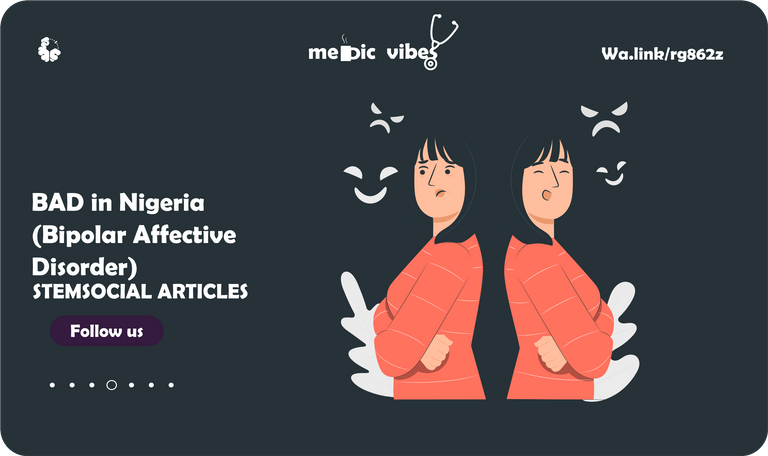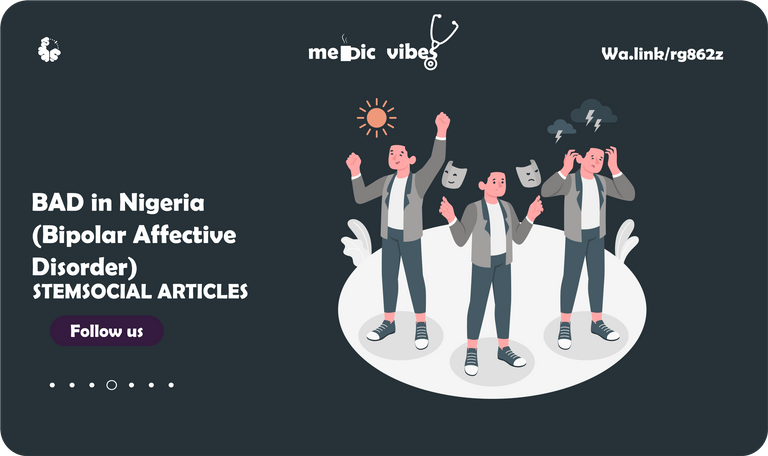BAD in Nigeria 4/7-Discussions (Demographics Part 1)

Inkscape.org
Depression vector created by pch.vector - www.freepik.com and Inkscape.org
In the last post, we talked about some neurotransmitters that are found to be related to BAD, particularly those with strong evidence like serotonin, norepinephrine and dopamine. In the study, we looked at men who were more commonly affected with BAD than females whereas in the normal population they are found to be equal. A young population was seen in the study and the mean age was around 30. There were also some euthymic patients in the study.

Inkscape.org
Depression vector created by pch.vector - www.freepik.com and Inkscape.org
Welcome to Medic Vibes, where we discuss mental health disorders and make sense of them. Dr. Ebingo Kigigha is a medical doctor (aspiring psychiatrist) and creative person (illustration and music). This has been our routine for two consecutive months. This month will be dedicated to BAD, or Bipolar Affective Disorder. The first month, we discussed Depression, and the subsequent month, anxiety. We'll begin with a discussion of a study, as we did two months ago.
In previous posts, we have introduced the study and discussed previous research describing the characteristics of Bipolar Affective Disorder. In this post, we will continue to discuss the study. This research was conducted in Enugu, Nigeria. About 820 thousand people live in the state of Enugu. Today, we will be looking at the study's discussions.

Patients who are bipolar have these major depressive episodes and manic episodes. Mood disorders are also called affective disorders 2 months ago, we talked about depression, among the types of depression is Major Depressive Disorder which is otherwise known as unipolar depression.

History
King Saul's features in the bible, were typical of mood disorders when he would have David play for him in his palace. Hippocrates believed depression was a result of black bile and he called it Melancholic (meaning Black Bile). The first person to describe depression in English text was done by Robert Burton. His book Anatomy of Melancholy dates back as far back as 1621. Emil Kraepelin developed the criteria that is still used for manic-depressive psychosis. It was called folie circularie.
Demographics
Among all the mood disorders BAD I has the earliest onset. The prevalence of BAD I is equal in men and women. Episodes of mania are seen more in men while depressive episodes occur more in women. Depression appears to have a higher occurrence in rural areas, there is a tendency for schizophrenia to be misdiagnosed by practitioners from a different culture from the patient.
Other Associated Conditions
People who deal with mood disorders are significantly at risk of dealing with alcohol abuse or dependence, anxiety disorders particularly panic, obsessive-compulsive and phobias, particularly for people and socialising. In the same manner, those who use illicit substances and abuse alcohol put themselves at risk of mood disorders. Women particularly have eating disorders when they go through unipolar and bipolar disorders.
People who are Bipolar when compared to those who have unipolar conditions are more likely to abuse substances. In Epidemiological studies, those with bipolar mood disorders were more likely twice the time to abuse substances and have anxiety disorders: Panic and OCD than unipolar mood disorders.
Having substance abuse problems significantly worsens the chances of the patient getting better and increases the chances that they might commit suicide.
Cause of Mood Disorders
We can speculate on the cause of mood disorders because antidepressants such as Venlafaxine affect the concentration and effect of the neurotransmitter at the synaptic cleft. Among the biogenic amines that have affected the mood on the synaptic cleft are the names more likely to be brought up as related mood disorders are serotonin and Norepinephrine. There is also a new subtype of dopamine and also the regulation mechanisms of dopamine are still being understood.
Cholinergics
The cerebral cortex has neurons that are called cholinergic neurones because of their receptors for the neurotransmitter Acetylcholine. These cholinergic neurones behave differently in the presence of monoamines we discussed yesterday. People who were studied after their death and had been depressed show abnormal levels of the precursor of this neurotransmitter. This may be giving insight into the phospholipid bilayer of the cell but even the drugs that antagonise and those that act synergistically with this neurotransmitter have different clinical effects.
The synergistic drugs can make the patient lethargic and cause retardation in psychomotor responses and may cause worsening of depression while reducing manic symptoms. The results of this interaction are not typically used in treatment because they are not so significant, and the side effects of this interaction are usually very evident. Some mice in the experiment that responded to acetylcholine agonists were less likely to develop learned helplessness
Cholinergic agonists modulate the activities of the pathway between the hypothalamus, Pituitary gland and adrenal gland. The effect is similar to the sleep seen in severe depression. Patients whose mood disorder is remitting and those that have close relatives have a trait that resembles the sensitivity to cholinergic agonists.
GABA
Another neurotransmitter that is being looked at for its effect on mood disorders is γ-Aminobutyric acid (GABA). GABA inhibits the action of monoamine pathways that ascend especially the mesocortical and the mesolimbic. {{{}}} In depression there have been observations of reduced GABA in plasma, Cerebrospinal fluid and the brain.
Stress over a long period has also been seen to reduce the level of GABA. In an oppposite manner, antidepressants have been found to increase the number of receptors to GABA and some drugs that act to synergise with GABA have a noticeable but insignificant antidepressant effect.
Glycine and glutamate act to cause inhibition and excitation of the nervous system. Glutamate and glycine bind to a receptor called N- methyl-D-aspartate (NMDA) when there is excess stimulation it leads to toxic effects on the nervous system.
There is a higher concentration of NMDA receptors in the hippocampus. This may be because of the effect of glutamate's function in working against neurocognitive decline seen in recurrent severe depression as works with hypercortisolemia. New studies are showing that the NMDA receptors may have an antidepressant function.
Second messengers
The binding of neurotransmitters to receptors usually brings about a cascade of reactions that lead to some intracellular processes controlled by second messengers within the nerve cells. These receptors in their intracellular work with guanine nucleotide-binding protein or G protein. This protein is linked to other intracellular enzymes like adenylate cyclase and phospholipid C that manage ATP and form second messengers. The second messengers control neuronal membrane ion channels. There is also proof that mood stabilizers act on these G proteins and second messengers.

Discussions (Demographics Part 1)

This study is the first of its kind in Southeast Nigeria. The statistical features of the study were similar to those seen in developed countries. The study had a mean age of 33.17 years which was very different from studies that had people over the age of 40. in developed countries.
In other studies, the number of women also outweighed the number of men. This is thought to be a result of the population findings in Engug as a whole where there are more men. Another reason might be that more attention is being paid to male patients. A similar finding was seen in a study done in Ethiopia so this may be a uniquely African feature.
The patients were also found to be mostly single. This may be the cause of the young who were included in the study were more. Another reason may be because these young patients usually find it hard to get married while dealing with this condition what with the stigma surrounding it. Another study done by Makanjuola on mania showed similar results. Younger people have a lower dropout rate than older people because the initial phase of treatment seems manageable until treatment goes on for too long and people struggle to keep up and eventually start looking for other options for treatment like unorthodox treatment and religion.
More than 80% had secondary school education which coincides with what is seen in the general picture, It is also not worthy that only one patient had no formal education. In Ethiopian studies, there was a good fraction of the study did not have any formal education. This may be attributed to the literacy level in southeast Nigeria which is notably high.
Another significant finding was that despite the high literacy level, most of those in the study were unemployed. This is very similar to the picture seen in other studies. The case in Nigeria may not be simply because mental illness is causing unemployment. After all, those who are healthy also can’t find jobs.

Tips
Many studies agree that the best treatment for mood disorders are pharmacotherapy and psychotherapy some studies suggest that both works effectively for mood disorders so long as they are mild. Also doing both might increase the cost of treatment.
The main psychotherapy method used short-term for major depressive disorder is cognitive therapy, interpersonal therapy and behavioural therapy. Most of these are however not as effective as psychoanalytical therapy that is usually used to treat depression.
The difference in these therapy methods is the short-term goals of the short methods and the key role played by the therapist in psychoanalytical therapy.
A new therapy method gathering some attention is dynamic therapy. This method was found to be comparable to cognitive therapy in some studies.
The national association for mental health treatment of depression collaborative research program have certain factors that can predict if the patient will get better. People who have less money get better with interpersonal therapy, the low cognitive ability works well with cognitive therapy with pharmacotherapy and severe depression works with interpersonal therapy and pharmacotherapy.

Hive Stories
@sam9999 explains in detail mental health conditions as a wonderful summary that can help anyone get started in building knowledge. Read more about this post here
Questions
- What did you learn about mood disorders?
- What did you learn about Bipolar disorder?
- What's the most interesting aspect of this study?
Conclusion
We learnt that mental health and emplyemnet in Nifgeria may not be directly related. There is a correlation between stigma and marriage in those with mental health constions. There are some neurotransmitters that need to be studied to understand their relationship with BAD.

I hope that you learned a lot from this post.
To book me for illustration gigs click Here
References
- Kaplan-Sadocks-Comprehensive-Textbook-Psychiatry
- Psychiatria
- Page demarcations made with Inkscape.org
Congratulations @ebingo! You have completed the following achievement on the Hive blockchain and have been rewarded with new badge(s):
Your next payout target is 4000 HP.
The unit is Hive Power equivalent because post and comment rewards can be split into HP and HBD
You can view your badges on your board and compare yourself to others in the Ranking
If you no longer want to receive notifications, reply to this comment with the word
STOPTo support your work, I also upvoted your post!
Check out the last post from @hivebuzz:
Support the HiveBuzz project. Vote for our proposal!
mood disorders have always been my challenge because I don't go out to associate with people. In that regard, I only communicate with myself.
Sorry about that.
When did you notice that start?
Thanks for your contribution to the STEMsocial community. Feel free to join us on discord to get to know the rest of us!
Please consider delegating to the @stemsocial account (85% of the curation rewards are returned).
You may also include @stemsocial as a beneficiary of the rewards of this post to get a stronger support.
That's an interesting post. Whereas you target studies made in Nigeria, I am wondering to which extent this is generalisable to other countries. Any information on this?
Cheers!
Well, some of the demographics we saw are, for example, we saw that younger age groups were affected by BAD. a majority of the data is only applicable to Africa, like the example of the educated participants, it was even very unique to Southeast Nigeria.
Thanks for reading though, How have you been?
Ok I see. I missed a few episodes f your series, and I was thus a bit lost. So generalisation conditions are similar to the previous series in which we chatted a bit last week. Is it correct?
I was quite busy by personal matters during those last day, and thus only partly there on chain. Hopefully I am back for good. Hopefully ;)
Don't worry, I will make the next episodes easier...especially next week when I start taking from social media,
Actually, this is a new topic from last week. This week is about Bipolar disorder, not anxiety.
Glad you are back, we missed you
I am never very far. But you know, sometimes real life catches you without notice. I am looking forward to the next topic.
Cheers!
Thanks....I sent you a discord message as regards @medicvibes the page is new and I have some ideas to promote @stemsocial with it
Oh, I rarely check Discord private messages. I will come back to you later today (if I don't forget). If needed, please send me a reminder in a public channel (those I check regularly).
Cheers!
Alright. I'lldo that in 6hours time
Hello @ebingo,
When I saw the title of this blog I had a good idea about what the discussion might entail. My experience with the disorder dates back to my days as a teacher. The school was dedicated to adolescents who had psychiatric disorders. The children were dealing with depression, eating disorder, schizophrenia and bipolar disorder. Those who struggled with depression ran a high risk of attempted suicide, but the children who suffered from schizophrenia and bipolar disorder seemed to be most difficult to treat. Their diseases required serious medication, and even then there would be breakthrough events.
For me, reading about bipolar disorder is not an objective exercise. I can see the faces of individuals (one especially ) who would be affected by this for a lifetime.
Thanks for writing about this issue. Information may not help those affected, but it will help the rest of us to understand the challenges in their lives.
Wow, being in this position requires a lot of mental strength. I know how these conditions can be, it's draining to take care of them especially when they get worse with treatment. I hope to go into research in non-pharmaceutical interventions...
Thank you for leaving your story here, I hope my readers see it too.
That has to be the future. First we have to understand so much more about how the brain works.
You do important work, important for all of us.
Yeah...We need to make a better place for those coming after us